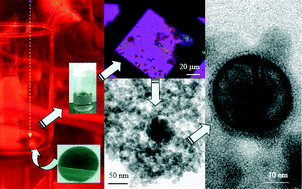Pulsed laser synthesis of diamond-type nanoparticles with enhanced Si–C solid solubility and special defects†
Abstract
Diamond-type Si–C particles with enhanced solid solubility were synthesized by pulsed laser ablation of 6H-SiC (10![[1 with combining macron]](https://www.rsc.org/images/entities/char_0031_0304.gif) 2) wafer in tetraethyl orthosilicate and characterized using X-ray/electron diffraction and optical spectroscopy. The C-overdoped Si, Si1+xC and Si-overdoped C nanoparticles underwent (hkl)-specific coalescence to form special grain boundaries, i.e. {111} twin boundary, (110) 70.5° twist boundary and [11
2) wafer in tetraethyl orthosilicate and characterized using X-ray/electron diffraction and optical spectroscopy. The C-overdoped Si, Si1+xC and Si-overdoped C nanoparticles underwent (hkl)-specific coalescence to form special grain boundaries, i.e. {111} twin boundary, (110) 70.5° twist boundary and [11![[1 with combining macron]](https://www.rsc.org/images/entities/char_0031_0304.gif) ](123)/(011) tilt boundary, and polycrystals up to several microns in size. Paracrystalline distribution of defect clusters and shock-induced 1-D 4×(111) faulting were also identified in the C-overdoped Si nanocrystals. The co-existent turbostratic graphene with varied Si–O–H content not only formed ribbons surrounding the diamond-type nanoparticles but also spherulites with bimodal basal spacing distribution due to dynamic constitutional supercooling. The overall refractory particles with significant photoluminescence (532, 603 nm) and violet light absorbance (3.1 eV) have potential opto-catalytic/electronic/abrasive applications and shed light on their natural occurrence in dynamic settings.
](123)/(011) tilt boundary, and polycrystals up to several microns in size. Paracrystalline distribution of defect clusters and shock-induced 1-D 4×(111) faulting were also identified in the C-overdoped Si nanocrystals. The co-existent turbostratic graphene with varied Si–O–H content not only formed ribbons surrounding the diamond-type nanoparticles but also spherulites with bimodal basal spacing distribution due to dynamic constitutional supercooling. The overall refractory particles with significant photoluminescence (532, 603 nm) and violet light absorbance (3.1 eV) have potential opto-catalytic/electronic/abrasive applications and shed light on their natural occurrence in dynamic settings.


 Please wait while we load your content...
Please wait while we load your content...